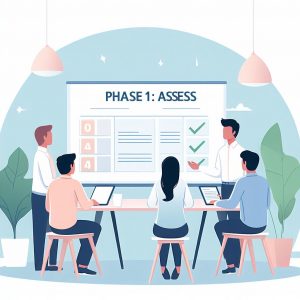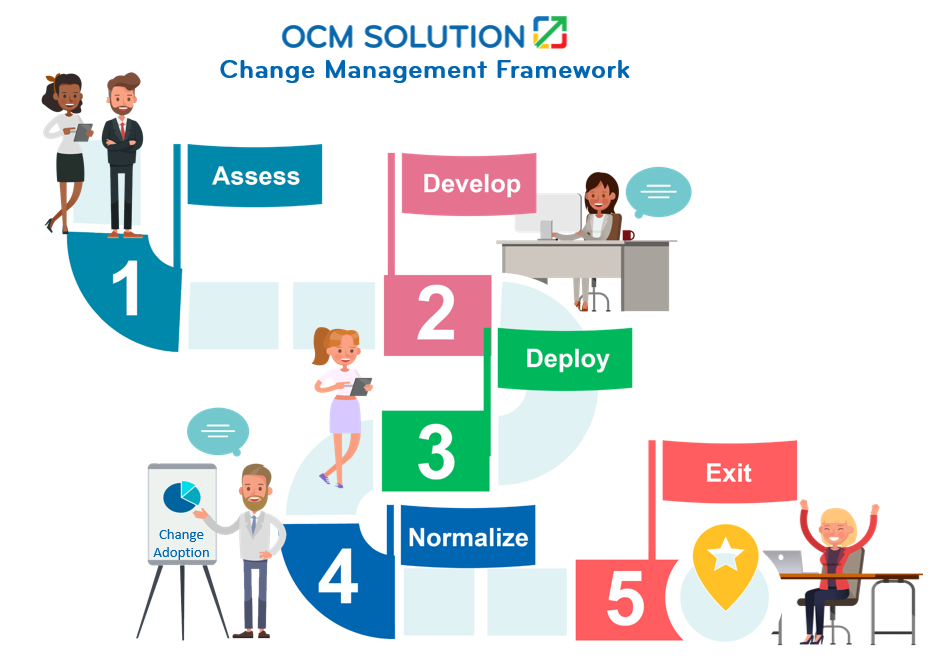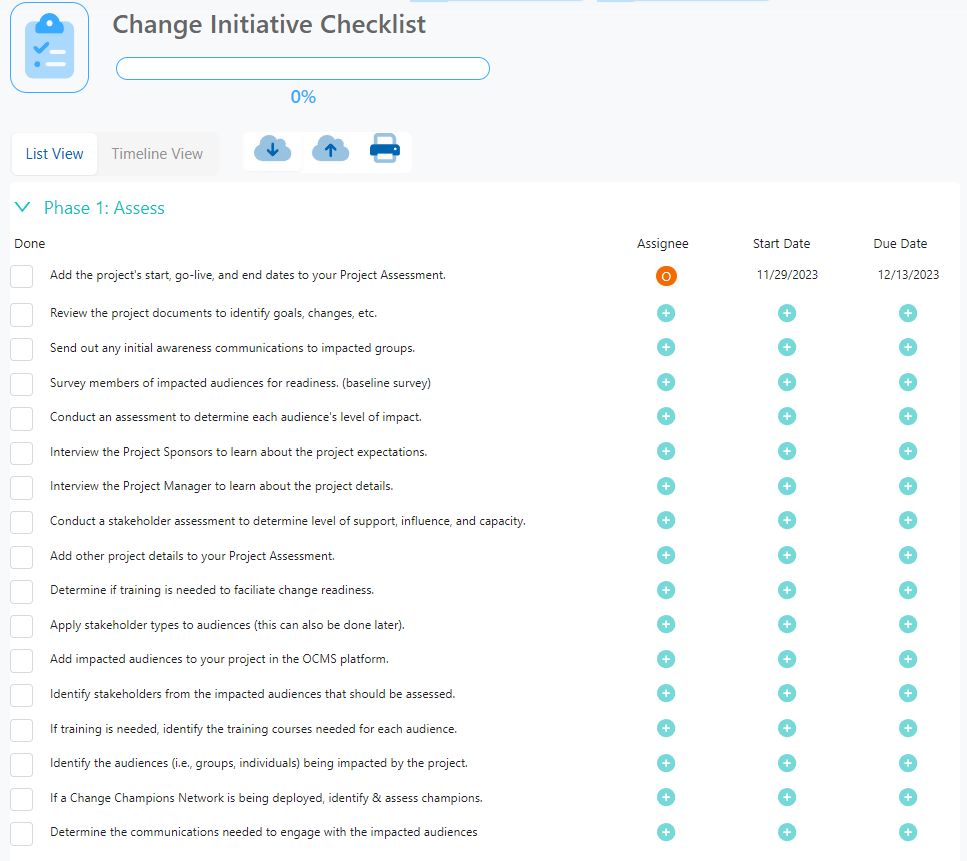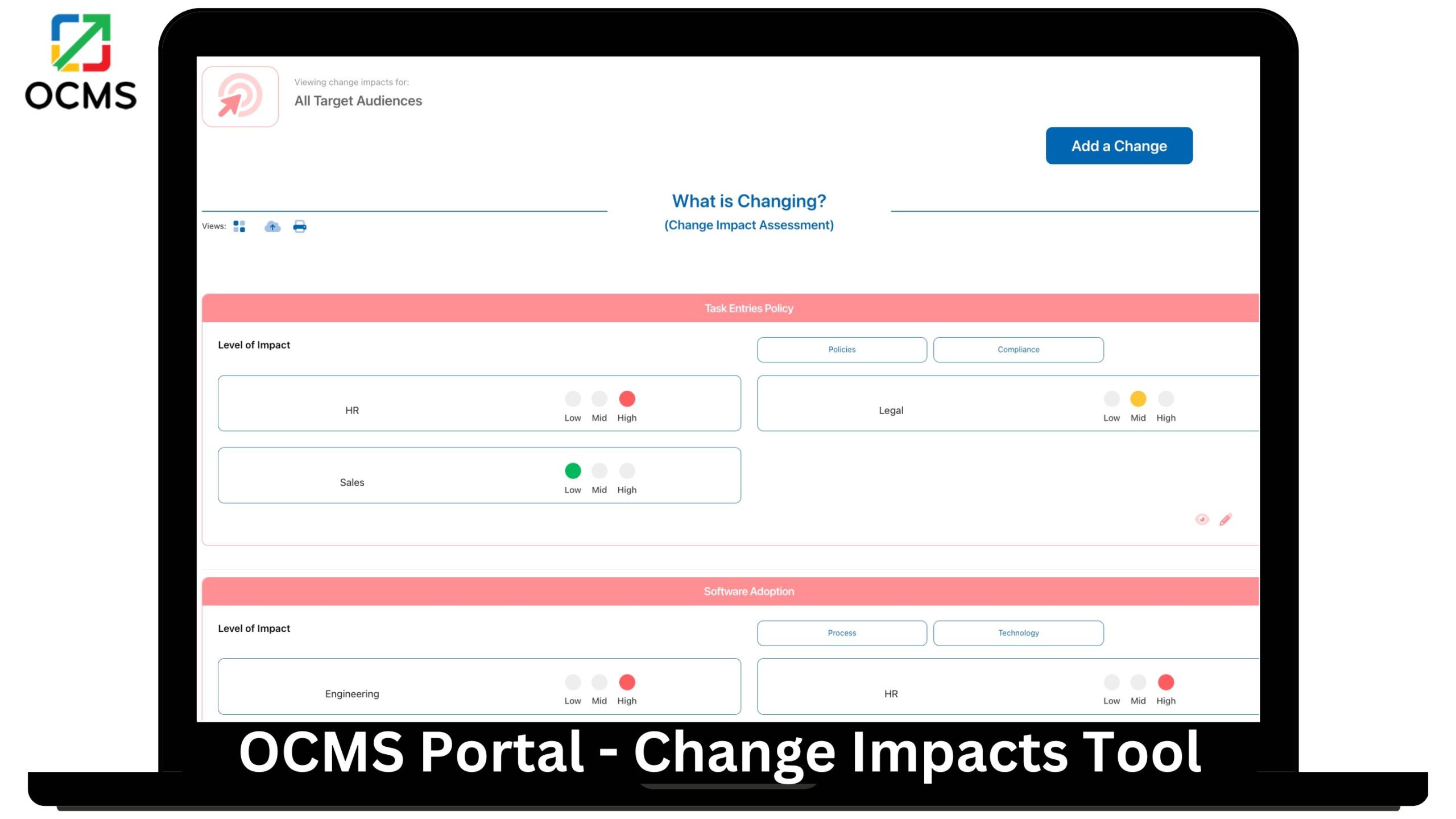Phase One of OCM
(1st Phase of OCM Involves Your Change Management Assessments)
Summary: Everything You Need to Know about OCM Assessment
 Welcome to a transformative journey in the realm of change management, where the first phase sets the stage for organizational evolution. In this article, we delve into the crucial initial steps of change management, a pivotal process that lays the foundation for successful transitions within any project.
Welcome to a transformative journey in the realm of change management, where the first phase sets the stage for organizational evolution. In this article, we delve into the crucial initial steps of change management, a pivotal process that lays the foundation for successful transitions within any project.
At the heart of effective change management lies the critical foundation provided by comprehensive OCM assessments to inform the crafting of a strategic change management plan.
Embracing a blend of insight and practicality, we explore the intricate dance of learning about a project and conducting Organizational Change Management (OCM) assessments. Join us as we navigate through the dynamic landscape of understanding a project and the evaluation techniques used in change management as you navigate the winds of change during the essential first phase of change management.
Define: Organizational Change Management
Organizational change management (OCM) involves helping an organization’s employees, customers, managers or external parties to accept, adapt and become proficient in a new solution that the organization is implementing. A new solution can include new business processes, new systems or technology, M&A, new products, company expansion, reorganization, new company vision, culture changes, etc.
The people that will be impacted by the new solution are referred to as impacted stakeholders or impacted end-users. These are the individuals and groups that need to be communicated with, engaged, trained, coached, educated and supported while the change is being implemented (and afterwards) to ensure that the change is successful, especially from a UX (user experience) perspective.
What Are the 5 Phases of Change Management?
Before we get into the Phase 1 stage of change assessment, let’s go through the five phases of change management. This 5-phase OCM model emphasizes a “manage by deliverables” approach and is a flexible framework that’s success focused.
- (Phase 1) Assess: Assess and understand the project and its impacts.
- (Phase 2) Develop: Develop detailed change management plans.
- (Phase 3) Deploy: Deploy OCM engagement and prepare the organization for the change.
- (Phase 4) Normalize: Support people to normalize the change adoption.
- (Phase 5) Exit: Complete final reporting and knowledge transfers.

Learn more about the OCMS Change Management Framework.
Phase 1 OCM Deliverables: Change Management Checklist
The first phase in the change management process involves conducting a series of change assessments to understand the scope, scale, impacts and overall nature of the project. It also includes the change management impact assessment to identify the changes occurring, who they’re impacting and how. Additionally, the phase 1 OCM assessment phase includes, identifying the stakeholders and employees that will be impacted by the change.
Additional assessments that are included in a phase 1 change management checklist template also include those for resistance, change readiness, training needs, and communication needs.
These assessments provide the vital information the OCM team needs to formulate a change management strategy and plan in support of the project. Keep reading to learn more about the evaluation techniques used in change management during this initial stage of the project.
Below is a management of change checklist for phase 1, the OCM assessment phase, from OCMS Portal’s Project Tasks Checklist.
OCMS Portal has everything you need to do change management from start to finish, including a prepopulated tasks checklist for all phases.
Change Management Process: Phase 1
During the 1st stage of change assessment, you’ll be doing a number of assessments. This is the information-gathering phase of your change management checklist template.
Your findings from these OCM assessments are essential, as they will provide output and insights for you to develop your change management strategies, tools, and plans for communicating and engaging with impacted end-users.
During the first phase of implementing your change program, you’ll want to conduct the following change assessments:
- Program / Project Assessment
- Target Audience Assessment
- Project Risk & Success Assessment
- Organizational Change Impact Assessment
- Stakeholder Assessment
- Resistance to Change Assessment
- Communication Needs Assessment
- Change Readiness Assessment
- Change Champion Network Assessment
- Training & Coaching Needs Assessment
Note: Before you begin the first assessment, it’s a good idea to ramp up on your change tasks using some type of management of change checklist or task list (such as the one mentioned above in the OCMS Portal software.)
Do you have any questions about evaluation techniques used in change management, change management impact assessment, or operational change management? Please reach out and let us know.
1. Program / Project Assessment:
The first step in the assessment process is to understand and document the nature of the change that the program/initiative is looking to implement.
This involves assessing the scope, scale, objectives of the change program, and the factors driving the change at hand. It also includes understanding the program’s deliverables, milestones, problem statement, solutions, the risks of not changing, and the “why now?” Click here to read more.
(Instructions for Completing Your Project Assessment).
2. Target Audience Assessment
Target Audience analysis involves identifying the list of names and contact information for all individuals (employees, customers, clients, partners, managers, leaders, and others) who will be impacted by the change. Click here to read more.
(Completing Your Audience Analysis – Instructions, Samples & Templates)
3. Change Risk Assessment
A change risk assessment involves assessing, documenting and understanding the type of risks that the company may face while this change is being implemented. You want to ensure that you identify any known trouble spots or potential areas for resistance. Click here to read more.
(Completing Your Change Risk Assessment – Instructions, Samples & Templates)
4. Organizational Change Impact Assessment:
The organizational change impact assessment involves understanding and documenting As-Is vs To-Be processes which will allow you to determine change deltas (a delta is a difference between what is being done today and what will be done in the future state). Using a change management impact assessment template, you can document the groups being impacted and the severity of the impacts for each process that is changing….. read more.
(Completing Your Change Impact Assessment – Instructors, Samples & Templates)
OCMS Portal with Organizational Change Impact Assessment Tool
Get the best evaluation techniques used in change management all wrapped up in one awesome software! OCMS Portal takes you through all phases of operational change management with assessments, built-in surveys, instant analytics reporting, and more. Sign up for a free trial today!
5. Stakeholder OCM Assessment:
The change management assessment of stakeholders will be used to identify key stakeholders (Executives, Leaders, Managers, etc.) that are needed to support the program. Your stakeholder analysis will also involve assessing each stakeholder’s level of receptiveness to the change, which will allow you to develop plans to enlist their buy-in and support. Click here to read more.
(Completing Your Stakeholder Assessment – Instructions, Samples & Templates).
6. Resistance to Change Assessment
A change resistance assessment involves identifying those stakeholders with low receptiveness indicated on the change management assessment of stakeholders. Then, analyzing each to understand what their reasons are for being resistant to the change initiative. It allows you to determine the best course of action to resolve their resistance. Click here to read more.
(Completing Your Resistance Analysis – Instructions, Samples & Templates)
7. Communication Needs Assessment
Another change management checklist item for phase 1 is your communication needs assessment. This involves reviewing your change management impact assessment, stakeholder assessment and resistance assessment and identifying the initial types of communications and communication channels needed for your OCM strategy. Click here to read more.
(Completing Your Communication Needs Analysis – Instructions, Samples & Templates)
8. Organizational Change Readiness Assessment
A change readiness assessment involves analyzing each impacted group’s readiness to adopt the change. It allows you to determine how ready a group (for example, a Sales or IT department) is to transition from their current way of operations to the target state model. It also allows you to understand each group’s awareness and acceptance (or lack of) to the transformation. Click here to read more.
(Completing Your Change Readiness Analysis – Instructions, Samples & Templates)
9. Change Champion Network Assessment
Change champion networks are a powerful component of any change strategy. Change champions allow the change team to move ownership of the change to the business units and groups that will be impacted by the change. This decreases the magnitude and duration of productivity dips and also improves the chances of the change sticking long-term. Click to read more.
(Launching Your Change Champion Network – Instructions, Samples & Templates)
10. Training & Coaching Needs Assessment
Often, impacted individuals and groups need to be trained in the new processes or tools that they are required to adopt. Training encourages comfort and proficiency in a new transformation, which increases adoption.
Likewise, managers or change champions may need to be coached or mentored to learn how they can best support the project’s success. The training needs analysis and coaching needs analysis are designed to identify what types of training or coaching needs to be included in the OCM Plan. Click to read more.
(Completing Your Training Needs Analysis – Instructions, Samples & Templates)
Phase 1 Conclusion: Evaluation Techniques Used in Change Management
As we conclude this exploration into the inaugural phase of change management, we stand at the precipice of possibility. Armed with newfound insights and guided by the invaluable change management assessments, organizations are poised to embark on a journey of meaningful transformation.
The seeds of change have been sown through understanding, and the roots firmly anchored in the assessments, setting the stage for a flourishing future. Let this initial phase serve as a catalyst, propelling teams toward a collaborative, adaptive, and resilient future.
FAQ – 1st Stage of Change Assessment
What are the 5 phases of change management?
According to the OCMS Change Management Framework, the five phases of change management are: Phase 1: Assess, Phase 2: Develop, Phase 3: Deploy, Phase 4: Normalize, and Phase 5: Exit.
What is the main purpose of OCM Phase 1?
The first phase in the change management process involves conducting a series of change assessments to understand the scope, scale, impacts and overall nature of the project. It also includes the change management impact assessment to identify the changes occurring, who they’re impacting and how.
What should you do before your first OCM assessment?
Before you begin the first assessment, it’s a good idea to ramp up on your change tasks using some type of management of change checklist or task list (such as the one mentioned above in the OCMS Portal software - ocmsolution.com)
Note: Content on OCM Solution's ocmsolution.com website is protected by copyright. Should you have any questions or comments regarding this OCM Solutions page, please reach out to Ogbe Airiodion (Change Management Lead) or the OCM Solutions Team today. OCM Solution was previously known as Airiodion Global Services (AGS).
External Sources: stock.adobe.com







